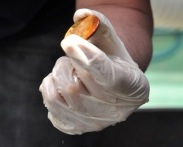The following is the text of a news release from Odyssey Marine Exploration:
(TAMPA, Fla.) — Odyssey Marine Exploration Inc., a pioneer in the field of deep-ocean exploration, recovered nearly 1,000 ounces of gold during the first reconnaissance dive to the SS Central America shipwreck site on April 15.
Recovered gold included five gold ingots and two $20 Double Eagle coins (one 1857 minted in San Francisco and one 1850 minted in Philadelphia). The gold ingots were stamped with assayer's marks and weights that range from 96.5 to 313.5 troy ounces.
The two-hour reconnaissance dive was conducted during the transit of Odyssey's research vessel, Odyssey Explorer, from the United Kingdom to Charleston, S.C., to mobilize for the project, which is being conducted under contract with the receiver of Recovery Limited Partnership (RLP). RLP director of operations Craig Mullen and RLP chief scientist/historian Bob Evans accompanied the Odyssey team for the dive operation. Evans previously served as chief scientist, historian and later as curator for the initial Central America recovery operations conducted between 1988 and 1991.
During the dive, Odyssey's ROV Zeus flew over the shipwreck to assess the current condition of the site. Gold ingots and other artifacts were clearly visible on the surface of the site during the dive and no excavation was required for their removal. Given the reconnaissance purpose of the dive, only five gold ingots, two gold coins, a bottle, a piece of pottery, a sample of the shipwreck's wooden structure, and an element of a scientific experiment that was left at the site more than 20 years ago were recovered. The positions of the recovered artifacts were documented for archaeological purposes and will be noted in the detailed site plan that is being created. The archaeological excavation of the site will be undertaken once the pre-disturbance survey provides detailed documentation of the site.
"This dive confirms for me that the site has not been disturbed since 1991, when I was last there," said Evans.
Mullen added, "The skill exhibited and results achieved during the initial reconnaissance dive reinforces our belief that the Odyssey team was the absolute best choice for this project. In addition to the cargo recovery operation, we plan to collect deep-ocean biological samples for Dr. Timothy Shank, a deep-ocean biologist and head of the Molecular Ecology and Evolution Laboratory at Woods Hole Oceanographic Institution. Our objective is to document and provide Dr. Shank with samples of species that have returned to the site since previous operations ended. Odyssey's documentation capabilities will contribute significantly to scientific understanding of deep-ocean biological processes. This continues a history of supporting scientific research at the site."
Odyssey was selected for the project by Ira Owen Kane, the court-appointed receiver who represents Recovery Limited Partnership and Columbus Exploration LLC (CE). The contract has been approved by the Common Pleas Court of Franklin County, Ohio, which has given Kane responsibility with overseeing the recovery project.
The archaeological excavation, valuable cargo recovery and ship-board conservation will be conducted and underwritten by Odyssey on behalf of RLP. In return, Odyssey will receive 80 percent of recovery proceeds until a fixed mobilization fee and a negotiated day rate are paid. Thereafter, Odyssey will receive 45 percent of the recovery proceeds.
About the SS Central America
The SS Central America was a 280-foot wooden-hulled, copper-sheathed, three-masted side-wheel steamship launched in 1853 as the SS George Law. Operating during the California Gold Rush era, the ship was in continuous service on the Atlantic leg of the Panama Route between New York and San Francisco, making 43 round-trips between New York and Panama. The Central America was caught in a hurricane and sank 160 miles off the coast of South Carolina on Sept. 12, 1857. When she was lost, the SS Central America was carrying a large consignment of gold for commercial parties, mainly in the form of ingots and freshly minted U.S. $20 Double Eagle coins. Because of the large quantity of gold lost with the ship, public confidence in the economy was shaken, which contributed to the Panic of 1857.
The Columbus-America Discovery Group, acting as agent for RLP, confirmed the location of the Central America shipwreck site in September 1988 at a depth of 7,200 feet. Recovery operations were conducted over a four-year period (1988-1991) and a large quantity of commercial gold was recovered from approximately 5 percent of the shipwreck site during more than 1,000 hours of bottom time.
Odyssey Marine Exploration has been awarded the exclusive contract to conduct an archaeological excavation and recover the remaining valuable cargo from the SS Central America shipwreck.

